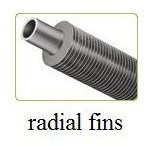A Fin Tube Exchanger Works Well as an Air Heat Exchanger
Introduction
For a liquid-liquid heat exchanger, the use of a finned tube isn’t normally needed, because the heat transfer coefficient for both sides of the heat transfer surface is relatively high. For an air heat exchanger, however, where one of the fluids is air or some other gas, the air side heat transfer coefficient will be much lower, so additional heat transfer surface area, as in a fin tube exchanger is very helpful. The overall flow pattern for a finned tube exchanger is often crossflow, but it can also be counterflow or parallel flow.
General Configuration of a Fin Tube Exchanger
A finned tube heat exchanger will typically have tubes with fins attached to the outside of them. There will
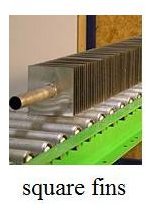
usually be a liquid flowing through the inside of the tubes and air or some other gas flowing outside of the tubes, where the additional heat transfer surface area due to the finned tube, increases the heat transfer rate. For a crossflow fin tube exchanger, the fins will typically be radial fins either circular or square, as shown in the pictures in this section.

Most finned tube heat exchangers are crossflow, using finned tubes somewhat like the upper pictures. For a counterflow or parallel flow fin tube exchanger, the fins should be longitudinal instead of radial, as shown in the lower diagram at the left. Finned tubes may be used as internal tubes in an enclosed heat exchanger, but in many cases with an air heat exchanger, the air flows through an open heat exchanger as shown in the next section, where some typical applications of finned tube heat exchangers are shown and discussed.
Examples of Fin Tube Heat Exchangers
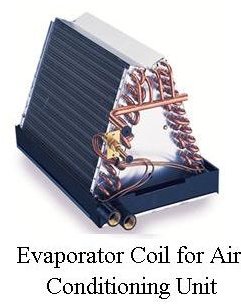
Finned tube heat exchangers are used in a variety of household applications and as industrial
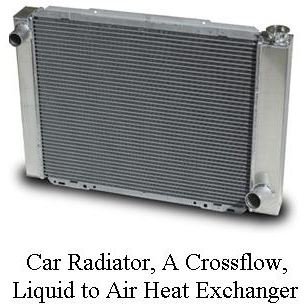
heat exchangers. An air heat exchanger like the evaporator coil for an air conditioning unit is typically a fin tube exchanger like that shown in the diagram at the left. Another common fin tube air heat exchanger is the car radiator, as shown at the right. The purpose of the car radiator is to cool the hot water in the tubes with the air passing through in crossflow. The air conditioner evaporator coil has the purpose of cooling the air passing through it.
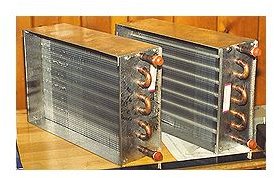
A fin tube exchanger can be used as an industrial heat exchanger also. A picture is shown at the left. An application that has seen widespread expansion recently is ‘dry cooling’ for steam power plants. This consists of using an air cooled condenser instead of a water cooled condenser. Interest in dry cooling for steam power plants has increased because of concern about the amount of water use and thermal effects on water bodies from the traditional cooling systems, ‘once through cooling’ and ‘closed system - cooling tower cooling.’
Image Credits
Radial fin and square fin tubes: https://www.fintube.com/
AC evaporator coil: https://www.residential.carrier.com/products/coils/evaporator/updowna.shtml
Car radiator picture: https://www.prcracing.com/aluminum-radiators.html
Finned tube heat exchanger: https://www.heatexchangermanufacturers.com/finnedtube-heatexchangers.php3
About the Author
Dr. Harlan Bengtson is a registered professional engineer with 30 years of university teaching experience in engineering science and civil engineering. He holds a PhD in Chemical Engineering
Related Reading
1. Features and Characteristics of the Spiral Heat Exchanger - This article provides information about the general configuration, flow patterns and advantages of a spiral heat exchanger in comparison with other heat exchanger types.
2. Features and Characteristics of the Flat Plate Heat Exchanger - This article provides information about the configuration of the flat plate heat exchanger and its advantages and disadvantages in comparison with other heat exchanger types.
3. What is a Heat Exchanger? They’re All Around You - This article give basic information about heat exchangers and various types that are present in everyday life.
